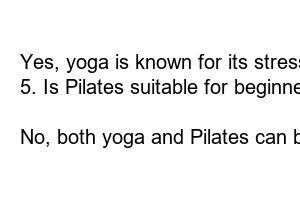요가 필라테스 차이
Are you looking to improve your overall fitness and flexibility? Have you heard about yoga and Pilates but aren’t sure about the difference between the two? Let’s break it down for you in this blog post, exploring the key differences between yoga and Pilates.
**What is Yoga?**
Yoga is a ancient practice that focuses on strengthening the mind and body through a series of poses, breathing exercises, and meditation techniques. It is often associated with improving flexibility, reducing stress, and promoting mental clarity.
**What is Pilates?**
Pilates, on the other hand, is a more recent form of exercise developed by Joseph Pilates in the early 20th century. It primarily focuses on core strength, stability, and alignment, using equipment such as reformers and stability balls to enhance the workout.
**Differences in Focus**
While both yoga and Pilates emphasize mind-body connection and overall wellness, yoga tends to focus more on flexibility and relaxation, whereas Pilates is geared towards building strength, stability, and alignment.
**Breathing Techniques**
In yoga, breathwork is a crucial component of the practice, with specific breathing techniques used to enhance the poses and promote relaxation. Pilates also incorporates breathing techniques, but the emphasis is more on core engagement and stability.
**Equipment Usage**
Another key difference between yoga and Pilates is the use of equipment. While yoga primarily relies on a yoga mat and sometimes props like blocks or straps, Pilates often utilizes equipment such as reformers, stability balls, and resistance bands to enhance the exercises.
**Physical Benefits**
Both yoga and Pilates offer a wide range of physical benefits, including improved strength, flexibility, and posture. However, yoga may be more beneficial for those looking to focus on flexibility and relaxation, while Pilates is ideal for individuals seeking to build core strength and stability.
**Which One Should You Choose?**
Ultimately, the choice between yoga and Pilates comes down to your personal fitness goals and preferences. If you’re looking to improve flexibility and reduce stress, yoga may be the way to go. On the other hand, if you’re aiming to strengthen your core and improve posture, Pilates could be a better fit for you.
**Summary**
In conclusion, yoga and Pilates are both effective forms of exercise that offer unique benefits for the mind and body. Whether you choose to practice yoga for flexibility and relaxation or Pilates for core strength and stability, incorporating both into your fitness routine can lead to a well-rounded workout regimen.
**FAQs:**
1. Can I practice both yoga and Pilates in the same day?
Yes, you can practice both yoga and Pilates on the same day, but it’s important to listen to your body and not overdo it.
2. Do I need to be flexible to do Pilates?
No, Pilates can actually help improve flexibility over time, so don’t worry if you’re not super bendy when you first start.
3. Is yoga or Pilates better for weight loss?
While both can contribute to weight loss when combined with a healthy diet, Pilates may be more effective for building lean muscle mass.
4. Can yoga help with stress relief?
Yes, yoga is known for its stress-relieving benefits, including deep breathing and relaxation techniques.
5. Is Pilates suitable for beginners?
Yes, Pilates can be modified for all fitness levels, making it suitable for beginners looking to build strength and stability.
6. Are there any age restrictions for practicing yoga and Pilates?
No, both yoga and Pilates can be adapted for all ages and fitness levels, so anyone can enjoy the benefits of these practices.

